|
|
|
Sort Order |
|
|
|
Items / Page
|
|
|
|
|
|
|
| Srl | Item |
| 1 |
ID:
105085
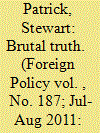

|
|
|
|
|
| Publication |
2011.
|
| Summary/Abstract |
The last 20 years -- so blandly labeled the "post-Cold War era" -- might as well be known as the "Age of Failed States." After decades of confronting Soviet power, successive U.S. administrations suddenly became embroiled in and bedeviled by the world's most dysfunctional countries. Although great-power competition persists, it is often the world's basket cases -- from Somalia to Afghanistan, Haiti to Liberia, and Pakistan to Yemen -- that dominate the U.S. foreign-policy agenda. This trend began in the early 1990s, when a shocking outbreak of state collapse and internal violence, including but by no means limited to episodes of genocide in the former Yugoslavia and Rwanda, seemed to herald a "new world disorder," in the words of British diplomat David Hannay.
|
|
|
|
|
|
|
|
|
|
|
|
|
|
|
|
| 2 |
ID:
155230
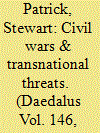

|
|
|
|
|
| Summary/Abstract |
Among the primary strategic rationales for U.S. policy engagement in war-torn states has been the assumption that internal violence generates cross-border spillovers with negative consequences for U.S. and global security, among these transnational terrorism, organized crime, and infectious disease. Closer examination suggests that the connection between internal disorder and transnational threats is situation-specific, contingent on an array of intervening factors and contextual conditions. Taken as a cohort, war-torn states are not the primary drivers of cross-border terrorism, crime, and epidemics, nor do they pose a first-tier, much less existential, threat to the United States. Of greater concern are relatively functional states that maintain certain trappings of sovereignty but are institutionally anemic, thanks to endemic corruption and winner-take-all politics. Ultimately, the most important U.S. stakes in war-torn countries are moral and humanitarian: namely, the imperative of reducing suffering among fellow members of our species.
|
|
|
|
|
|
|
|
|
|
|
|
|
|
|
|
| 3 |
ID:
080159
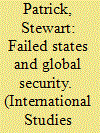

|
|
|
| 4 |
ID:
097851
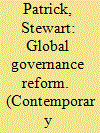

|
|
|
| 5 |
ID:
099376
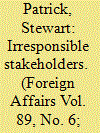

|
|
|
| 6 |
ID:
053875
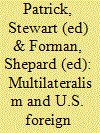

|
|
|
|
|
| Publication |
London, Lynne Rienner Publishers, 2002.
|
| Description |
vii, 507p.
|
| Series |
Studies in multilateralism
|
| Standard Number |
1588260186
|
|
|
|
|
|
|
|
|
|
|
|
Copies: C:1/I:0,R:0,Q:0
Circulation
| Accession# | Call# | Current Location | Status | Policy | Location |
| 046614 | 327.73/PAT 046614 | Main | On Shelf | General | |
|
|
|
|
| 7 |
ID:
090950
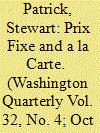

|
|
|
|
|
| Publication |
2009.
|
| Summary/Abstract |
Tremendous forces are eroding the institutional foundations of world politics. Economic power is moving to developing countries (particularly in Asia), transnational security threats from nuclear proliferation to climate change are emerging, and influential malevolent as well as benign non-state actors compete with sovereign states for global influence. Despite these tectonic changes, the superstructure of global cooperation has barely moved. The world thus makes do with creaky institutions that reflect a world that no longer exists-with growing risks to global stability and prosperity.
|
|
|
|
|
|
|
|
|
|
|
|
|
|
|
|
| 8 |
ID:
081570
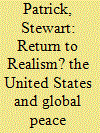

|
|
|
| 9 |
ID:
126272
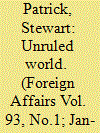

|
|
|
|
|
| Publication |
2014.
|
| Summary/Abstract |
While campaigning for president in 2008, Barack Obama pledged to renovate the dilapidated multilateral edifice the United States had erected after World War II. He lionized the generation of Franklin Roosevelt, Harry Truman, and George Marshall for creating the United Nations, the Bretton Woods institutions, and NATO. Their genius, he said, was to recognize that "instead of constraining our power, these institutions magnified it." But the aging pillars of the postwar order were creaking and crumbling, Obama suggested, and so "to keep pace with the fast-moving threats we face," the world needed a new era of global institution building.
|
|
|
|
|
|
|
|
|
|
|
|
|
|
|
|
| 10 |
ID:
068907
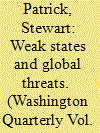

|
|
|
| 11 |
ID:
145757
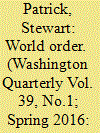

|
|
|
|
|
| Summary/Abstract |
The international rules-based order established after World War II seems to be under relentless pressure, threatening its foundations existentially. If so, what if anything can be done to reinvigorate it? This question raises several others a priori: First, what are the most distinctive attributes of the post-1945 world order; how did that order come into being; and what explains its longevity? Second, what forces are now placing this order under strain? Third, what aspects of today's order are most vulnerable—and which are most resilient? Fourth, what principles, frameworks, and objectives should guide U.S. policy toward world order going forward? This essay seeks to answer those fundamental questions in an effort to strengthen the foundation of global stability and order.
|
|
|
|
|
|
|
|
|
|
|
|
|
|
|
|
|
|
|
|
|